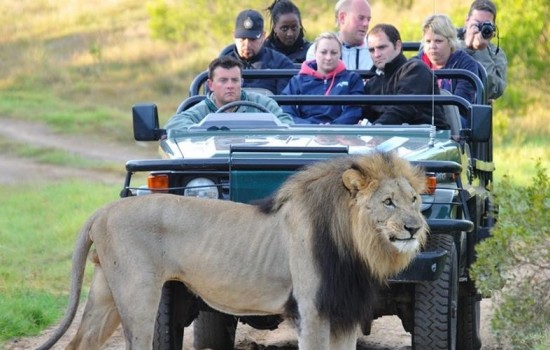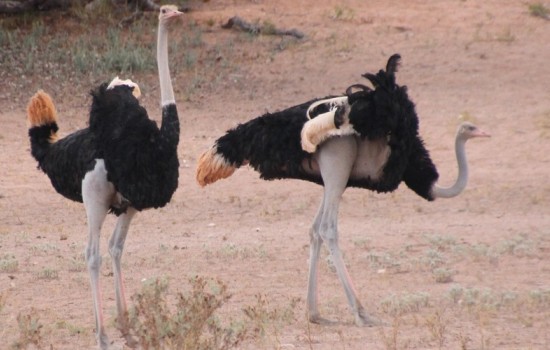Pilanesberg Big Five Safari Dag Toer

(malaria free!)
“the volcano that gave birth to a game reserve”
Day Tour: Pick up at your accommodation in Pretoria or Johannesburg with a trained tour guide who is also a registered Field Guide.
Travel via Hartebeespoort dam and the majestic Magaliesberg mountain range to the unique Pilanesberg game reserve which is located in the largest volcanic crater of its kind in the world and is home to lion, elephant, buffalo, rhino and leopard, the Big Five. Along theway we make a short detour to a lion breeding station and have the opportunity to play with lion cubs. Lunch is taken at a lodge situated in the reserve itself overlooking a waterhole before venturing into the park for a close encounter with nature.
The Pilanesberg game reserve is situated in a malaria free area and offers one of the best opportunities to view a wide variety of African game in their natural habitat. The area is truly spectacular and being a transition area between bush and semi desert vegetation one sees different species seldom seen in one locality together. Our trained field guide will be able to interpret the majesty and complex interrelationships in nature. After an African sunset over the rim of the extinct volcano we head back to Johannesburg in time for you to enjoy a late dinner at your own hotel.
Transport throughout is in a luxury microbus vehicle and you will be back in Johannesburg at approximately 8 o’clock.


About Pilanesberg Game Reserve.
Pilanesberg Game Reserve is in the Bojanala Region of the North West Province, adjacent to Sun City. Set in the crater of a long extinct volcano, the Park ranks among the largest of the parks in South Africa (it is in fact the fourth largest park) and covers an area of 55 000 hectare. The beauty of Pilanesberg is reflected in a large central lake, the Mankwe Dam. Over time, wind and water have carved a spectacular landscape with rocky outcrops, open grasslands, wooded valleys and thickets. Pilanesberg National Park accommodates virtually every mammal of southern Africa. Also home to the Big Five.
General:
Visitors are offered many opportunities to experience the wonders of Pilanesberg. There are nearly 200 kilometres of excellent quality roads for either self-drives or guided drives, and professional guides operate within the park. Numerous hides and scenic picnic sites enable the tourist to experience “out-of-car” experiences as well.
Bird-life:
Bird watching is excellent with over 300 species recorded. Some are migrants, others permanent inhabitants; some eat carrion or live prey, others eat seeds, fruit or tiny water organisms. There is a self-guided trail in the Walking Area at Manyane Complex in the east, which offers environmental education whilst enjoying game viewing and bird watching on foot. Also at Manyane is a walk-in aviary with over 80 species of indigenous birds.
“The Volcano that gave birth to a game reserve”
The crater of a long extinct volcano is the setting of Pilanesberg Game Reserve- a fascinating alkaline complex produced by volcanic eruptions some 1300 million years ago. Pilanesberg is one of the largest volcanic complexes of its kind in the world. Its rare rock types and structure make it a unique geological feature. The area is fringed by three concentric ridges or rings of hills – the formation rises from the surrounding plains like a bubble. The structure of the park is termed the “Pilanesberg Game Reserve Alkaline Ring Complex”.
Ancient, even by geological time scales, this extinct volcano is the most perfect example of an alkaline ring complex. A number of rare (but not necessarily economically important) minerals occur in the park. Pilanesberg Game Reserve rates high amongst the world’s outstanding geological phenomena. Pilanesberg has survived ages of erosion and stands high above the surrounding bushveld plains. The early presence of man can be seen in the numerous Stone and Iron Age sites that are scattered throughout the park.
The park exists within the transition zone between the dry Kalahari and wetter Lowveld vegetation, commonly referred to as “Bushveld”. Unlike any other large park, unique overlaps of mammals, birds and vegetation occur because of this transition zone. Springbok, brown hyena, the red eyed bulbul, and camel thorn trees usually found in arid areas are found cohabitation with moist-area-limited impala, black eyed bulbul and Cape chestnut trees. The colourful hues,
varied habitats and panoramas will delight and entertain photographers and visitors. The very topography makes the area a feast for the eye. Here are syenite koppies, thickly forested ravines, typical bushveld and also rolling grasslands and lightly wooded areas.
Off the centre of the park is Thabayadiotso, “the Proud Mountain”. The Park ranks among the largest of the parks in South Africa (it is in fact the fourth largest park) and covers an area of 55 000 hectare.


